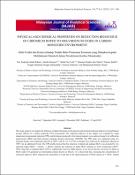Options
Physical and Chemical Properties on Reduction Behaviour of Chromium Doped to Molybdenum Oxide in Carbon Monoxide Environment
Journal
Malaysian Journal of Analytical Sciences (MJAS)
Date Issued
2023
Author(s)
Nur Syakirah Abdul Rahim
Alinda Samsuri
Mohd Nor Latif
Maratun Najiha Abu Tahari
Fairous Salleh
Tengku Shafazila Tengku Saharuddin
Norliza Dzakaria
Muhammad Rahimi Yusop
Abstract
This study aimed to investigate the influence of added chromium on the physical and chemical reduction behavior of molybdenum trioxide (MoO3) in a carbon monoxide (CO) environment. The reduction behavior of the sample was evaluated by using temperature-programmed reduction (TPR), and the phases produced by the reduced samples were analyzed using X-ray diffraction spectroscopy (XRD) and field emission scanning electron microscopy (FESEM). The TPR study was conducted using two reduction modes: non-isothermal reduction at 700°C with 20 vol. % of CO in nitrogen (N2), followed by isothermal reduction at 700°C for an additional 60 min. The TPR profile showed that the reduction of doped and undoped MoO3 was preceded by two reduction stages (MoO3 → Mo4O11 → MoO2), wherein, the reduction of doped MoO3 starting at a lower temperature (380°C500°C) than that of undoped MoO3 (550°C). Additionally, based on XRD analysis, it was shown that the conversion of MoO3 to MoO2 under CO generated an intermediate product known as Mo4O11. It is discovered that, increasing the concentration of chromium doped to MoO3 enhanced the reducibility of oxide due to the rapid production of MoO2 phases at T: 380ºC. Further heating under CO atmosphere, carbide species built up in the form of Mo2C rather than metallic Mo which might be due to excess of CO exposure to the surface layer of oxide.
Subjects
File(s)
Loading...
Name
Physical and Chemical Properties on Reduction Behaviour of Chromium Doped to Molybdenum Oxide in Carbon Monoxide Environment.pdf
Size
1.59 MB
Format
Adobe PDF
Checksum
(MD5):efff31ad02050912fc0c3c3004684730